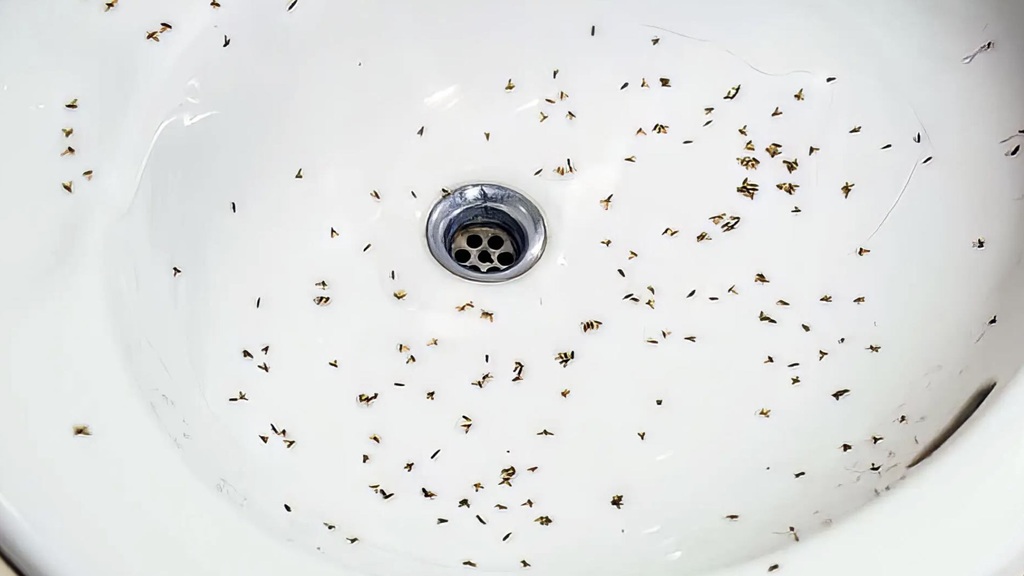
There’s nothing quite as annoying as a swarm of tiny, buzzing insects dancing around your kitchen, houseplants, or even your computer screen. Often, these unwelcome guests are mistakenly lumped together as “gnats,” but in reality, you might be dealing with fruit flies, fungus gnats, or even drain flies. While all are small and bothersome, understanding their key differences is crucial for effective identification and, more importantly, for implementing the right control strategies.
This comprehensive guide will help you decipher whether you’re battling fruit flies or gnats, pinpoint their breeding grounds, and equip you with practical, eco-friendly tips to reclaim your home from these miniature invaders.
The Great Divide: Fruit Flies vs. Gnats
Before we delve into specific identification and control, let’s establish the fundamental distinctions between fruit flies and the various types of gnats you’re likely to encounter.
Fruit Flies (Drosophilidae)
- Appearance: Typically 1/8 inch long, with a tan to brownish-black body and distinct red eyes (though some species have dark eyes). They have a somewhat round or oval shape.
- Flight Pattern: Often fly in a slow, erratic, almost “loopy” pattern. They tend to hover around their food source.
- Attraction/Food Source: Primarily attracted to fermenting fruits and vegetables, ripening produce, sugary spills, soda, alcohol, and even rotting organic matter in drains. They’re drawn to the yeast produced during fermentation.
- Life Cycle: Very rapid, completing their life cycle in as little as 8-10 days under ideal conditions. A single female can lay hundreds of eggs.
- Where you’ll find them: Kitchens, pantries, near fruit bowls, garbage cans, compost bins, recycling bins, and occasionally drains.
Gnats (Various Families)
The term “gnat” is a general, non-scientific term that can refer to several small, winged insects. The most common “gnats” you’ll encounter indoors are fungus gnats and drain flies.
Fungus Gnats (Sciaridae and Mycetophilidae)
- Appearance: Slender, delicate bodies, usually black or dark brown, about 1/16 to 1/8 inch long. They have long antennae and grayish wings. They often resemble tiny mosquitoes.
- Flight Pattern: Weak, erratic flyers. They tend to “stumble” through the air and prefer to walk or run across surfaces. You’ll often see them near houseplants.
- Attraction/Food Source: Attracted to moist potting mix, decaying organic matter in soil, and fungi. Their larvae feed on fungi, algae, and decaying plant matter in the soil, and sometimes on plant roots, especially in overwatered plants.
- Life Cycle: Also relatively fast, around 3-4 weeks.
- Where you’ll find them: Hovering around houseplants, growing trays, greenhouses, or any area with consistently moist soil.
Drain Flies (Psychodidae), also known as Moth Flies
- Appearance: Small (1/16 to 1/4 inch), fuzzy, moth-like appearance with broad, hairy wings held roof-like over their bodies when at rest. They are typically gray or black.
- Flight Pattern: Poor, short-distance flyers. They often hop or crawl.
- Attraction/Food Source: Attracted to stagnant water and decaying organic sludge in drains, sewers, septic tanks, and even seldom-used sinks or bathtubs. Their larvae feed on this organic film.
- Life Cycle: Approximately 1-3 weeks.
- Where you’ll find them: Near drains, sinks, showers, bathtubs, basements, or any area with persistent moisture and organic buildup.
How to Identify Your Tiny Tormentors: A Step-by-Step Guide
Now that you know the general characteristics, let’s get down to some practical identification tips.
- Observe Their Location:
- Kitchen/Fruit Bowls/Garbage: Strongly points to fruit flies.
- Around Houseplants: Almost certainly fungus gnats.
- Near Drains/Sinks/Showers: Likely drain flies.
- Examine Their Appearance (if you can get close enough!):
- Red Eyes, Stocky Body: Definitely a fruit fly.
- Long Antennae, Delicate, Mosquito-like: Most likely a fungus gnat.
- Fuzzy, Moth-like, Hairy Wings: A clear sign of a drain fly.
- Watch Their Flight Pattern:
- Slow, Loopy, Hovering: Classic fruit fly behavior.
- Erratic, Stumbling, Near Plants: Characteristic of fungus gnats.
- Short Hops, Crawling, Near Drains: Points to drain flies.
- Consider the Source: What are they attracted to?
- Fermenting anything: Fruit flies.
- Moist soil: Fungus gnats.
- Sludgy drains: Drain flies.
Control is Key: Tailored Solutions for Each Pest
Once you’ve accurately identified your pest, you can implement targeted and effective control measures. A “one-size-fits-all” approach rarely works for these distinct insects.
Eradicating Fruit Flies
The golden rule for fruit fly control is sanitation, sanitation, sanitation!
- Eliminate Food Sources:
- Refrigerate or promptly consume ripe fruits and vegetables. Don’t leave them out on counters.
- Rinse produce thoroughly before storing to remove any potential eggs.
- Empty garbage and recycling bins frequently, especially those containing food scraps or empty beverage containers.
- Clean up spills immediately, particularly sugary drinks and alcohol.
- Wipe down counters, sinks, and appliances regularly to remove any sticky residues.
- Trap ‘Em!
- Apple Cider Vinegar Traps: Pour a small amount of apple cider vinegar into a shallow bowl, add a few drops of dish soap (to break surface tension), and cover with plastic wrap secured with a rubber band. Poke a few small holes in the plastic. The fruit flies will be attracted to the vinegar, enter the holes, and drown.
- Wine/Beer Traps: A small amount of old wine or beer in a glass can also work effectively.
- Commercial Fruit Fly Traps: Many effective traps are available that use attractants and sticky surfaces.
- Address Drains (if suspected): While primarily attracted to fruit, fruit flies can sometimes breed in the organic film inside drains if there’s a suitable food source. Pour boiling water down drains, or use a mixture of baking soda and vinegar followed by hot water.
Conquering Fungus Gnats
Controlling fungus gnats revolves around managing soil moisture.
- Don’t Overwater! This is the most crucial step. Allow the top 1-2 inches of potting mix to dry out completely between waterings. Fungus gnat larvae thrive in consistently moist soil.
- Improve Drainage: Ensure your plant pots have adequate drainage holes. Avoid letting pots sit in standing water.
- Sterilize Potting Mix: If you reuse pots, clean them thoroughly. Consider baking or microwaving small batches of potting mix (before planting!) to kill any existing gnat eggs or larvae.
- Sticky Traps: Yellow sticky traps placed near houseplants are highly effective at catching adult fungus gnats, helping to reduce the breeding population.
- Beneficial Nematodes (for severe infestations): These microscopic worms are natural predators of fungus gnat larvae and are safe for plants, pets, and humans. They can be applied to the soil.
- Hydrogen Peroxide Drench (caution advised): A dilute solution of hydrogen peroxide and water can kill larvae on contact in the soil. Use with caution, as it can be harsh on sensitive plants. Always research the appropriate dilution for your plants.
- Top Dressing: Cover the top inch or two of soil with sand, pebbles, or diatomaceous earth. This creates a dry barrier that discourages female gnats from laying eggs and makes it difficult for emerging adults to escape.
Related: How to Get Rid of Ground Bees Nest: Safe and Effective Methods
Eliminating Drain Flies

Drain fly control focuses on removing their breeding material: the organic sludge.
- Thorough Drain Cleaning:
- Boiling Water: Pour boiling water down all drains, particularly those where you’ve seen drain flies.
- Baking Soda and Vinegar: Pour 1/2 cup baking soda down the drain, followed by 1/2 cup white vinegar. Let it fizz for 30 minutes to an hour, then flush with hot water.
- Drain Brushes: Use a long, flexible drain brush to physically scrub the inside of pipes, especially the P-trap and the area just below the drain opening. This dislodges the organic film.
- Enzymatic Drain Cleaners: These products use enzymes to break down organic matter in drains without harsh chemicals. Follow product instructions carefully.
- Address Other Moist Areas: Check for any other sources of stagnant water and organic buildup, such as leaky pipes, clogged gutters, or infrequently used sumps.
- Seal Cracks: If drain flies are coming from cracks in concrete or foundation, seal them to prevent entry.
Prevention is the Best Defense
Once you’ve eradicated your current infestation, consistent preventative measures are key to keeping your home free of these tiny nuisances.
- Maintain Kitchen Cleanliness: Regularly clean up food spills, empty trash, and store produce properly.
- Don’t Overwater Plants: Learn your plants’ watering needs and stick to them. Use well-draining potting mix.
- Keep Drains Clean: Make regular drain cleaning a part of your household routine, especially for seldom-used sinks or showers.
- Inspect New Plants: Before bringing new houseplants into your home, inspect them for signs of pests in the soil or on the leaves.
- Seal Entry Points: Ensure window screens are intact and doors seal properly to prevent outdoor pests from entering.
Related: Butterfly Bush Care: Tips for a Thriving Garden
Conclusion
While fruit flies and gnats can be incredibly frustrating, they are not invincible. By understanding their distinct characteristics, breeding habits, and preferred environments, you can effectively identify your unwelcome guests and implement targeted control strategies. Remember, the most powerful tools in your arsenal are vigilance, consistent sanitation, and a little bit of knowledge. With these tips, you’ll be well on your way to a pest-free home, enjoying your fruit, plants, and clean drains without the constant buzz of tiny invaders.





